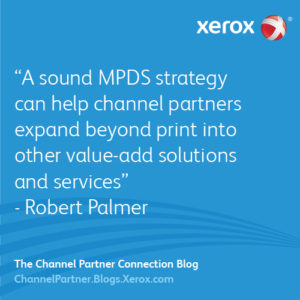
Today, printing is viewed less as a standalone business function and more as a component of an overall document and content strategy. The desire to control print costs coupled with the need to optimize the document infrastructure is driving the continued transition to managed print and document services (MPDS). Among the many benefits, MPDS helps organizations make better, more informed decisions about print and document delivery.
These same trends are having a dramatic impact on the makeup of the office equipment channel. With the installed base shrinking and the number printed pages on the decline, channel partners must find ways to capture additional market share or take on new lines of business to compensate for lost revenue from the sales of consumable supplies. But for many this transformation has not come easy: finding ways to add value and differentiate from competitors is much more difficult these days.
A sound MPDS strategy can help channel partners expand beyond print into other value-add solutions and services—paving the way to new revenue streams with the potential to dramatically increase overall customer spend. But to take advantage of these opportunities, MPDS must be positioned as something much more than a basic subscription-based model for print services. At the same time, channel partners should take every step necessary to migrate from the traditional hardware-centric business model to a fully integrated services-led customer approach.
In B2B markets, customers are not just looking to buy goods and services—they invest in relationships. Indeed, the customer relationship is the backbone of the office equipment channel. But if this is true, why are so many channel partners, resellers, and other indirect channel providers struggling with the transition to a services model? The answer is quite simple:
Many channel partners continue to sell MPDS as a product rather than as a valuable solution designed to address specific business problems.
Selling Value Instead of Cost
Many service providers continue to promote MPDS primarily as a means for managing the fleet and reducing overall printing costs. The real value proposition of MPDS, however, is encompassed in the ability to reduce redundancy, drive operational efficiencies, and improve productivity. By leading with these elements, providers have the ability to deliver additional value by expanding beyond print into other managed services, such as IT-related services or business process optimization (BPO).
Selling purely on cost provides only short-term value to the customer. Once a baseline for cost reduction has been established, you remain vulnerable to competitors that could undercut your position once the contract is up for renewal. Selling on value is a much stronger position, and it is key to the successful transformation to a services-led business model. Customers should associate the value of your relationship with the services you provide, as opposed to the products you sell.
Differentiation is another area that remains elusive for some attempting to make the transition to services. Printers and MFPs have always been positioned as peripheral products designed to enable specific business functions: document scanning and output. Historically, channel partners have simply relied on the products they sell and the brands they carry to differentiate from competitors. But differentiating on hardware has become almost impossible these days. In fact, most OEMs now rely on the solutions enabled by the hardware platform as a way to distinguish offerings from those of competitors.
In a services-led approach, your long-term goal is to become a preferred provider for every customer you serve, which means understanding customer pain points and getting integrated into those business processes that are critical to their success. The key to building a successful MPDS practice for the future lies in developing strong expertise in digital workflow and information management.
Businesses now have access to a wealth of information that is used both internally and externally. This information must be managed, structured, stored, and made always-accessible to individuals both inside and outside the corporate firewall. Knowledge workers are creating content and leveraging information from multiple sources and file formats, all of which must be consolidated into a single document infrastructure that might involve complex business workflows. Meanwhile, as content and business processes migrate more to mobile workflows it adds yet another layer of complexity.
We have reached a true inflexion point for our industry. Businesses are struggling to deal with issues related to document workflow and information management. IDC’s research shows that mid-size organizations are evaluating MPDS not only to lower print costs but also to optimize processes and reduce the support and maintenance burden inside their own internal IT departments. Even if cost reduction is the primary objective, many organizations are seeking help from MPDS providers around a broader scope of document and content management needs.
Results from a recent IDC study of 600 U.S. users involved in workflow automation demonstrate why these issues have become so critical. Top pain points that influence automation decisions for companies with fewer than 500 employees are document workflows between departments, and the ability to approve documents in electronic format. For businesses with fewer than 100 employees, the number one pain point is manual data extraction form electronic documents. Companies with 100-499 employees indicate that document workflow pain points also focus on issues related to paper based document workflows and poor exception handling practices.
As organizations of all sizes become more comfortable with outsourcing print requirements, they will lean harder on providers to extend the capabilities of those services to ensure proper integration between document workflow and output, while at the same time driving greater ROI from their MPDS investment. Pursuing a value-based sales motion to drive alternative MPDS revenue streams will help combat the ongoing erosion in cost-per-page margins and help position your business for future success.
Subscribe to the Channel Partner Connection and receive email updates when we publish a new article.



